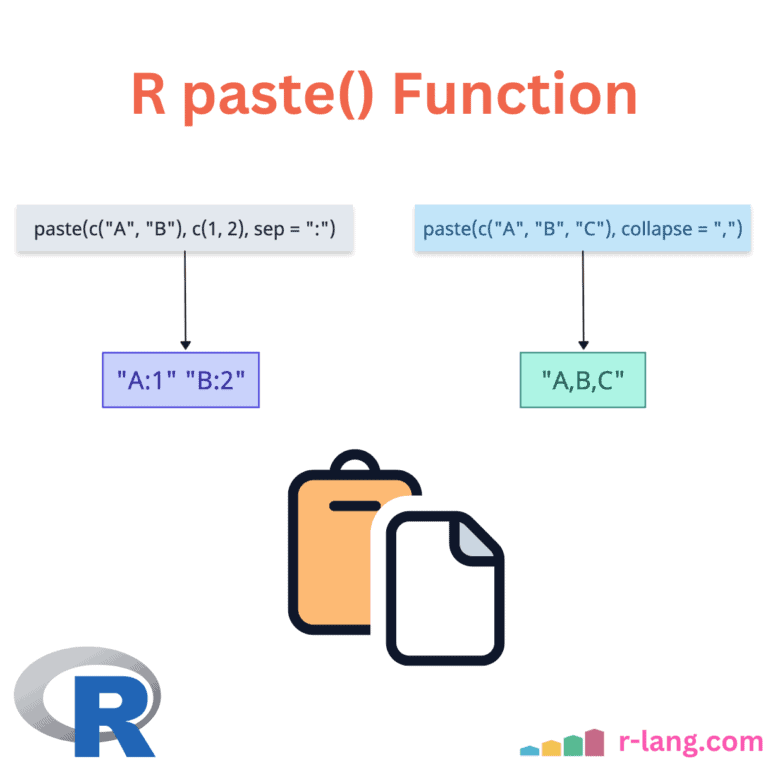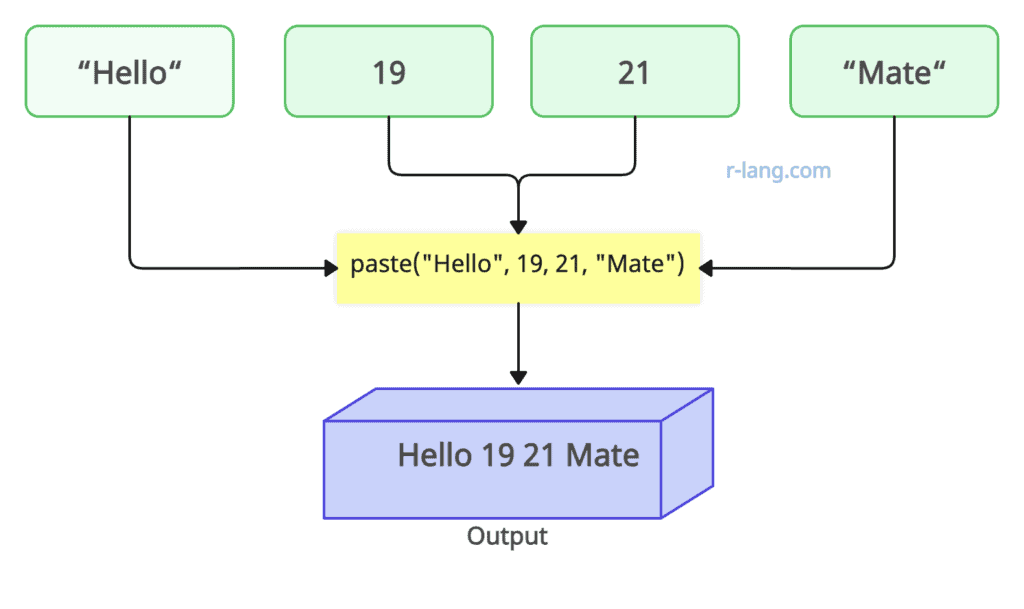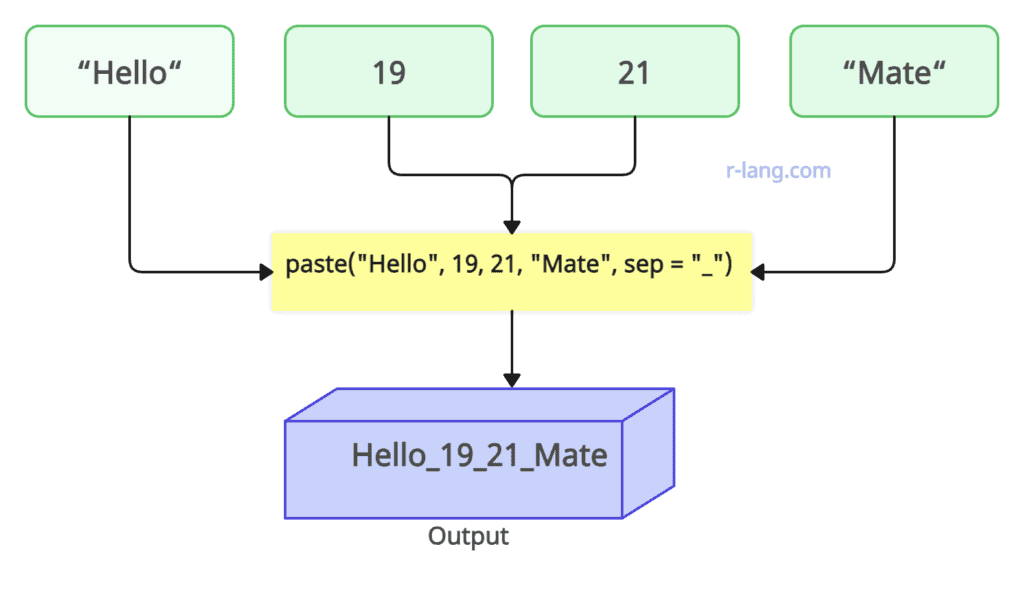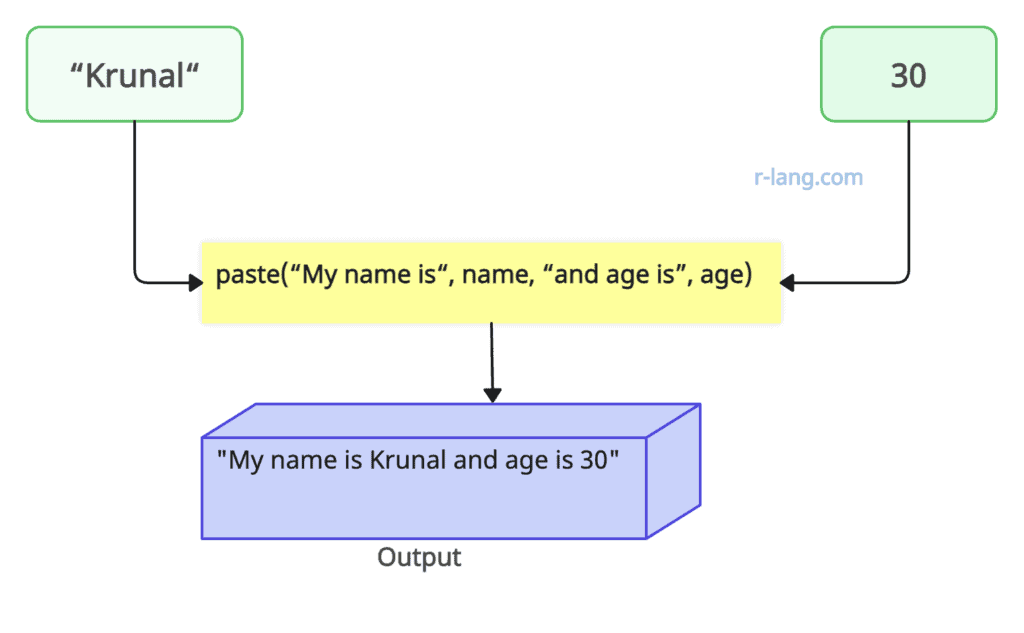The paste() function in R concatenates vectors after converting them to character.
paste("Hello", 19, 21, "Mate")
# Output: [1] "Hello 19 21 Mate"
It helps us combine multiple strings or vectors into a single string or vector of strings, with customizable separators, constructing file paths and URLs, creating composite keys from multiple variables, manipulating text data, formatting strings, or generating dynamic text.
Syntax
paste(data, sep=" ", collapse=NULL)Parameters
| Argument | Description |
| data | It is one or more R objects to be concatenated together. |
| sep | It is a character string to separate the terms. |
| collapse | It is NULL. It is an optional character string to separate the results. |
Passing the “separator”
If you pass the separator argument to this function, it will separate the elements.
paste("Hello", 19, 21, "Mate", sep = "_")
# Output: [1] "Hello_19_21_Mate"Collapsing a vector of strings
The collapse argument can define a value to use when joining those values to create a single string.
paste(c("K", "D", "L"), 1:9, sep = "|", collapse = " & ")
# Output: [1] "K|1 & D|2 & L|3 & K|4 & D|5 & L|6 & K|7 & D|8 & L|9"Concatenating text and a variable
name <- "Krunal"
age <- 30
paste("My name is", name, "and age is", age)
# Output: [1] "My name is Krunal and age is 30"Difference between paste and paste0()
The main difference between paste() and paste0() is that the paste() function uses a space (” “) as a default separator between the strings, whereas the paste0() function uses no space as a separator, which means it concatenates strings without any separator.
paste("hello", "mate", "how", "are", "you")
paste0("hello", "mate", "how", "are", "you")
# Output:
# [1] "hello mate how are you"
# [1] "hellomatehowareyou"
Handling non-character inputs
If the inputs are non-characters and you pass them to the paste() method, it will coerce them to characters.
num_vec <- c(1, 2, 3)
bool_vec <- c(TRUE, FALSE, TRUE)
result <- paste(num_vec, bool_vec, sep = ":")
print(result)
# Output: [1] "1:TRUE" "2:FALSE" "3:TRUE"Vector recycling
If you have two vectors with different lengths, shorter vectors are recycled to match the length of the longest vector.
longer_vec <- c("A", "B", "C")
shorted_vec <- "x"
combined_vec <- paste(longer_vec, shorted_vec, sep = "_")
print(combined_vec)
# Output: [1] "A_x" "B_x" "C_x"Empty input
If you pass the empty input, the output will be character(0).
empty_output <- paste()
print(empty_output)
# Output: character(0)NULL or NA values
The paste() function will ignore NULL and treat NA as the string “NA”.
output_with_null <- paste("Kaynes", NULL, "Technology")
print(output_with_null)
# Output: [1] "Kaynes Technology"
output_with_na <- paste("Kaynes", NA, "Technology")
print(output_with_na)
# Output: [1] "Kaynes NA Technology"Zero-length vectors
If you pass 0 0-length vector like character(0) to the paste() function, it returns character(0), which means empty.
zero_length <- character(0)
result <- paste(zero_length, "amber")
result
# Output: [1] " amber"That’s it!

Krunal Lathiya is a seasoned Computer Science expert with over eight years in the tech industry. He boasts deep knowledge in Data Science and Machine Learning. Versed in Python, JavaScript, PHP, R, and Golang. Skilled in frameworks like Angular and React and platforms such as Node.js. His expertise spans both front-end and back-end development. His proficiency in the Python language stands as a testament to his versatility and commitment to the craft.




